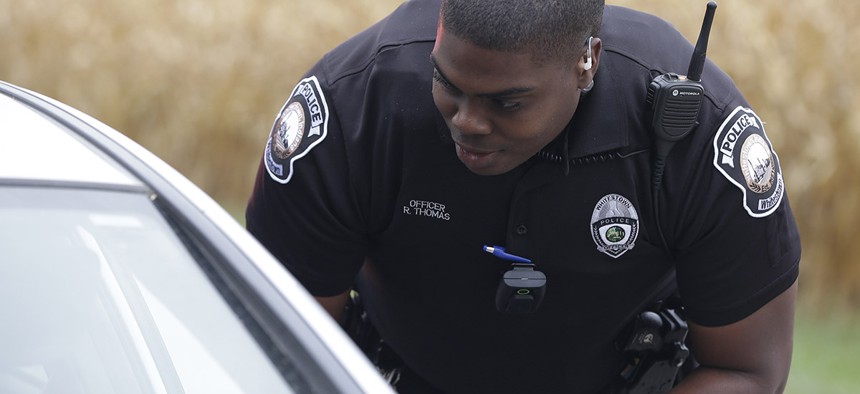In the Future, Body Cameras Won't Need Humans to Interpret Footage

A body camera is attached to the uniform of Whitestown Police Department officer Reggie Thomas during a traffic stop, in Whitestown, Ind. Darron Cummings/AP
The intelligence community wants technology that can interpret video feeds.
A growing number of security cameras, body-worn cameras and other safety and surveillance feeds means there's way too much video footage for human analysts to sift through, and a new federal research program seeks technology that can interpret that footage automatically.
An intelligence community research and development agency is looking for technology that could tell if a person in a video feed has a heart attack and falls, or if he or she is brandishing weapons. Specifically, the agency wants software that can detect people and objects from streaming sources, potentially depicting the same event from multiple feeds.
The Intelligence Advanced Research Projects Activity's Deep Intermodal Video Analytics program, or DIVA, could ease the burden on analysts for monitoring video at airports, border crossing and government facilities, according to a broad agency announcement made last month.
» Get the best federal technology news and ideas delivered right to your inbox. Sign up here.
Using analytics for "real-time alerting or triaging video" could help security personnel respond to incidents or later process footage for forensic analysis. Currently, identifying the relevant parts of videos is "manually intensive," and the DIVA program is intended to "automate much of this analysis."
Within the scope of DIVA, the technology should be able to identify activities such as a person throwing an object, abandoning a backpack, loading or getting into or out of a car, two people exchanging something, such as a suitcase, or several people meeting.
The program will be conducted in three phrases: The first will focus on identifying simpler activities from security camera feeds, such as a person getting out of car or carrying an object. The second would detect people abandoning or exchanging objects and carrying firearms by analyzing footage from body-worn cameras. The final phase would include technology that could recognize people and objects by processing several overlapping, or nonoverlapping, camera viewpoints.
DIVA plans to look at ways to track people without identifying them, and the program will not evaluate "person identification."
Eventually, the program could result in a "common framework and software prototype" for detecting activities, people and objects in a multi-camera network, the BAA said.
Proposals for the first round are closed Nov. 7. The BAA closes June 30, 2017.





